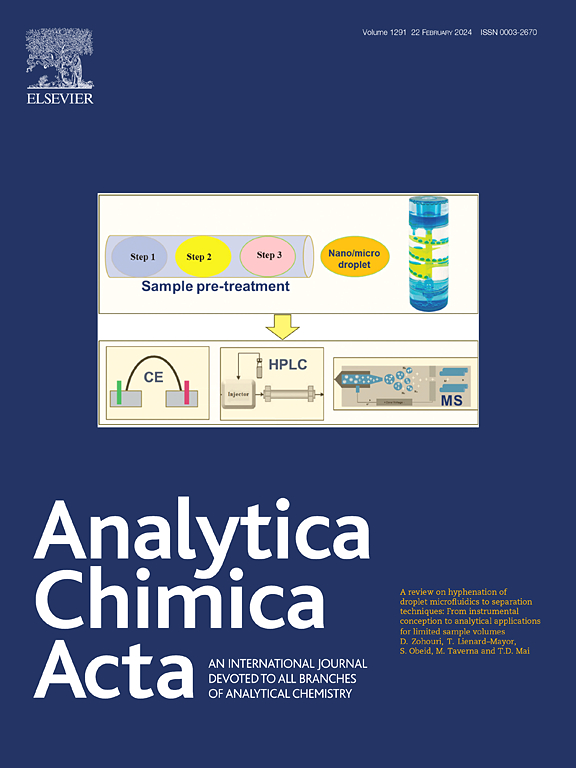Capture-SELEX-based screening and mechanism analysis for the dual-colorimetric aptasening of microcystin in water
IF 5.7
2区 化学
Q1 CHEMISTRY, ANALYTICAL
引用次数: 0
Abstract
Microcystins (MCs), a class of cyclic heptapeptides prevalent in aquatic ecosystems, pose significant hepatotoxic, nephrotoxic, neurotoxic, and reproductive risks to both human and environmental health. Current detection methods often lack cost-effectiveness or operational simplicity, highlighting the urgent need for innovative strategies to enhance the monitoring of MCs in water and food sources. This study proposes an aptamer-based approach to address these limitations by targeting three predominant MC variants: MC-LR, MC-RR, and MC-YR. A five-segment oligonucleotide library underwent 12 rounds of Capture-SELEX to identify aptamers with pan-specificity for MCs. The lead aptamer, designated as MCs-12, exhibited high-affinity binding (Kd = 19.47 ±5.35 nM) to all three conformers of MCs, as confirmed through colloidal gold spectrophotometry. Circular dichroism analysis, molecular docking studies, and dynamics simulations revealed potential binding interactions characterized by hydrogen bonding and hydrophobic effects. A dual-colorimetric biosensor utilizing the MCs-12 aptamer achieved dual-range linearity (0.25–10.00 ng/mL and 10.00–3,000.00 ng/mL), with limits of detection (LOD) at 0.08 ng/mL and 0.14 ng/mL respectively. Application of this biosensor to lake water samples resulted in recoveries ranging from 94.24% to 114.20%, demonstrating robustness within complex matrices. The MCs-12 aptamer represents a promising biorecognition element for the surveillance of microcystins due to its stability and specificity advantages over traditional antibodies. Furthermore, the dual-colorimetric platform effectively bridges the gap between laboratory-grade sensitivity and field-deployable simplicity—facilitating cost-effective monitoring of microcystin contamination in environmental and food samples. This work advances the field of aptamer-based biosensing for detecting aquatic toxins.

基于capture - selex的水中微囊藻毒素双比色适配体筛选及机制分析
微囊藻毒素(MCs)是一类普遍存在于水生生态系统中的环七肽,对人类和环境健康具有显著的肝毒性、肾毒性、神经毒性和生殖风险。目前的检测方法往往缺乏成本效益或操作简单,这突出表明迫切需要创新战略来加强对水和食物来源中微生物的监测。本研究提出了一种基于适配体的方法,通过针对三种主要的MC变体:MC- lr、MC- rr和MC- yr来解决这些限制。一个五段寡核苷酸文库进行了12轮Capture-SELEX筛选,以确定具有泛特异性的MCs适配体。通过胶体金分光光度法证实,先导适配体MCs-12与MCs的三种构象均具有高亲和力结合(Kd = 19.47±5.35 nM)。圆二色性分析、分子对接研究和动力学模拟揭示了以氢键和疏水效应为特征的潜在结合相互作用。使用MCs-12适配体的双比色生物传感器实现了双范围线性(0.25-10.00 ng/mL和10.00-3,000.00 ng/mL),检出限(LOD)分别为0.08 ng/mL和0.14 ng/mL。将该生物传感器应用于湖泊水样,回收率为94.24% ~ 114.20%,在复杂基质中表现出鲁棒性。与传统抗体相比,MCs-12适体具有稳定性和特异性优势,是一种很有前景的微囊藻毒素监测生物识别元件。此外,双比色平台有效地弥合了实验室级灵敏度和现场部署简便性之间的差距,促进了环境和食品样品中微囊藻毒素污染的成本效益监测。本研究为基于适体体的水生毒素生物传感技术的研究提供了新的思路。
本文章由计算机程序翻译,如有差异,请以英文原文为准。
求助全文
约1分钟内获得全文
求助全文
来源期刊

Analytica Chimica Acta
化学-分析化学
CiteScore
10.40
自引率
6.50%
发文量
1081
审稿时长
38 days
期刊介绍:
Analytica Chimica Acta has an open access mirror journal Analytica Chimica Acta: X, sharing the same aims and scope, editorial team, submission system and rigorous peer review.
Analytica Chimica Acta provides a forum for the rapid publication of original research, and critical, comprehensive reviews dealing with all aspects of fundamental and applied modern analytical chemistry. The journal welcomes the submission of research papers which report studies concerning the development of new and significant analytical methodologies. In determining the suitability of submitted articles for publication, particular scrutiny will be placed on the degree of novelty and impact of the research and the extent to which it adds to the existing body of knowledge in analytical chemistry.
 求助内容:
求助内容: 应助结果提醒方式:
应助结果提醒方式:


